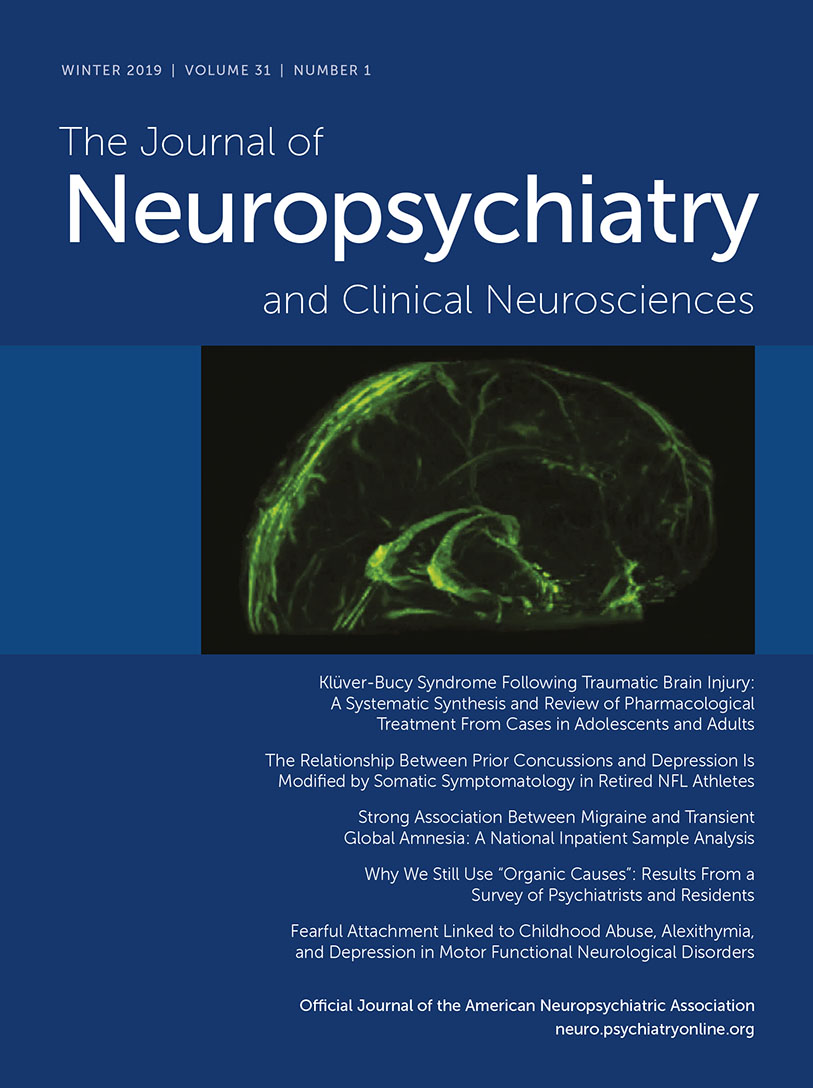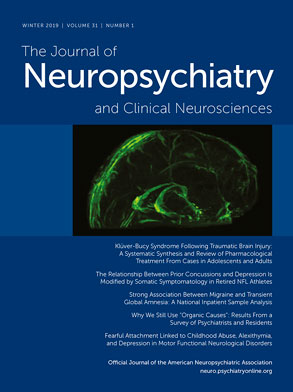Among individuals who experience traumatic brain injury (TBI), the prevalence of suicide, attempted suicide, and suicidal ideation is estimated to be 3–4 times greater than the prevalence in the general population.
1 The increased risk of suicide persists for more than 15 years after a TBI, suggesting that chronic factors linked to biological, cognitive, and behavioral changes may lead to unfavorable psychological and functional outcomes. By contrast, in the acute posttraumatic phase, one of the most commonly encountered phenomena is the onset of manifestations of delirium and psychomotor agitation. According to some studies, 11%–70% of patients with severe head injuries experience episodes of agitation.
2,3 This marked variability may be explained by the heterogeneity of this patient population in that the highest incidence is observed in individuals with pre-TBI personality disorders or a history of substance abuse as well as in individuals with damage in certain areas of the brain. The duration of agitation may vary from a few days to several weeks. Moreover, various external factors, such as pain, contention, excessive stimulation, an aggressive approach on the part of caregivers, and the use of psychotropic drugs, may trigger anxiety and exacerbate agitation.
4Here, we report the case of a 33-year-old patient who developed posttraumatic delirium following a TBI and who died by suicide 2 weeks after the injury, while she was still hospitalized.
Case Report
A 33-year-old woman sustained a concussive head injury with loss of consciousness in a road accident. When the paramedics arrived at the scene of the accident, she appeared to be wakeful, although confused and repetitive, and she was taken to the hospital. From an analysis of the patient’s medical history, the only noteworthy pathological finding to emerge was that the patient, who was an Argentinian citizen and a psychiatrist by profession, had experienced an episode of posttraumatic epilepsy following a domestic accident and had been receiving treatment with lamotrigine (100 mg) and topiramate (100 mg) for 6 years. She had never manifested any behavioral disorders, nor did she have a history of alcoholism or substance abuse. She was described by family members and friends as serene and good-humored as well as an esteemed professional. Toxicological tests of urine samples at the time of her arrival to the emergency department were negative for substances of abuse. The patient appeared to be wakeful, although agitated and confused, and her score on the Glasgow Coma Scale was 14/15. Results from her objective neurological examination were normal, and no motor deficits were observed. CT of her cranium revealed a picture of diffuse subarachnoid hemorrhage and multiple foci of lacerations and contusions in the left lateral and paramedian fronto-basal sites.
The patient was monitored for about 24 hours in the intensive care unit. While under sedation with fentanyl and morphine, she was soporous but easily roused and occasionally agitated. The patient was subsequently transferred to the neurosurgery ward, where for the first week, she remained in a mainly soporous state, with moments of agitation and confusion. In the second week, her episodes of psychomotor agitation became increasingly frequent. On objective neurological examination, she was described as wakeful, partially oriented, and sometimes dysphoric and agitated. On various occasions, she gathered up her belongings and attempted to leave the ward. Three days before her death, she managed to leave the building, and was found wandering around the hospital grounds in a state of confusion. Following this incident, she was kept under closer surveillance by the nursing staff and was placed on sedative therapy with haloperidol (2 mg b.i.d.). On the night of her death by suicide, the patient appeared to be particularly agitated and attempted to leave the ward several times. Given this state of agitation, the physician on duty prescribed an additional 2-mg dose of haloperidol, in addition to the two daily doses. Following the administration of this dose, the patient’s state of agitation improved, as noted in her clinical records, and she appeared to be calm. About an hour later, however, she threw herself from the window of her third-floor room and was killed instantly.
Discussion
A head injury triggers a series of molecular, biochemical, and cellular processes within the CNS, causing neural damage and cell death. This cascade of events causes blood-brain barrier dysfunction, altered homeostasis, cerebral metabolic imbalance, mitochondrial dysfunction, exotoxicity, and, finally, CNS damage.
6 From the psychiatric standpoint, a TBI may have a heavy impact on all aspects of life and cause social and psychological dysfunctions
7 and may even result in suicide. Indeed, as mentioned above, patients who experience a TBI have a significantly higher risk of suicide than the general population.
The relationship between TBI and suicide, however, has not been fully clarified.
8 According to some investigators, a TBI can act as a stress factor that precipitates a psychiatric disorder and, consequently, suicidal behavior.
9 Indeed, individuals with TBI may display high incidence of anomalies, which may be due to the effects of the TBI on brain functioning, the psychological impact of the trauma, or the psychosocial effects of the TBI.
10In an analysis of the timing of suicide in relation to TBI in the Finnish population from 1988 to 2004, Mainio et al.
11 found that the median time between the injury and death by suicide was 8 years (range, 2–12 years) among individuals who had sustained a brain lesion and 11 years (range, 4–19 years) among individuals who sustained a simple concussion. By contrast, in their analysis of a Danish population from 1979 to 1993, Teasdale and Engberg
7 reported a median time of about 3–3.5 years for all three diagnostic groups studied (concussion, skull fracture, and cerebral contusion/intracranial hemorrhage).
However, as demonstrated in our case report, death by suicide may also occur shortly after the injury, even during hospitalization to treat the organic pathology caused by the traumatic event itself. Our patient died by suicide 2 weeks after her injury, while she was still in the hospital. Although she was initially observed to be in a generally soporous state, she began to experience frequent episodes of psychomotor agitation several days after being hospitalized. It is known that posttraumatic agitation and delirium are among the most common early cognitive dysfunctions following TBI. This condition is manifested as stupor, characterized by fluctuations in mental state and in attention, which may manifest as disorganized thought and as an altered level of consciousness (hyperalertness, agitation, and lethargy). Dysarthria and acute onset of motor symptoms (tremor, myoclonus, and asterixis) may also be present.
12 In our case, the patients’ state of agitation was accompanied by a persistent desire to leave the hospital ward and loss of contact with reality.
The pathogenesis of posttraumatic delirium is clearly multifactorial and has not been fully clarified; whereas its substrate is certainly that of damage to the CNS due to the trauma, the mechanisms of its progression are uncertain. The three most probable mechanisms are neuroinflammation, altered neurotransmitter balance, and structural damage with dysregulation of the neuronal networks.
13 It is estimated that posttraumatic delirium may affect up to half of patients with mild or moderate head injuries within the first 4 days following the trauma.
14The association between posttraumatic delirium and suicide is not known; however, the results of a recent meta-analysis
5 indicate a moderate association between psychomotor agitation (which is a component of delirium) and the risk of suicide. However, further research will be necessary in order to examine the short-term risk of suicide in this patient population, given that posttraumatic delirium is not manifested in a homogeneous manner in the various clinical populations. For example, study subjects with previous cognitive disorders tend to develop delirium after even clinically mild injuries; this may be explained by the presence of inflammatory phenomena that are already under way and that may facilitate the onset of delirium.
15In the case described here, the patient’s psychiatric anamnesis was negative, and no history of alcohol or drug abuse was recorded. The only pathology that emerged was posttraumatic epilepsy, for which the patient had been receiving treatment with lamotrigine and topiramate for 6 years. This condition might, in itself, have constituted a risk factor. Indeed, there is evidence that, even in the absence of psychiatric comorbidities, the prevalence of suicide is higher among patients with epilepsy than in the general population, so much so that epilepsy is considered an independent risk factor for suicide.
16 Specifically, it has been suggested that individuals with epilepsy may experience neurobiological dysfunction involving neurotransmitter imbalance, which is a common feature among individuals with suicidal ideation.
17 In the present case, it may therefore be hypothesized that the patient’s epilepsy, on account of the above-mentioned alterations, constituted a basic state that facilitated the development of delirium as well as suicidal ideation following the TBI.
With regard to the features of our patient’s anatomical lesions, CT revealed the presence of diffuse subarachnoid hemorrhage and multiple foci of lacerations and contusions in the left frontal lobe. Although patients who have simple concussion are also at high risk of suicide,
7 it is possible that, in our patient, the frontal location of the lesions may have played a role in the neuropsychiatric alteration caused by the TBI. Indeed, it has been documented that lesions of the frontal lobes can suppress inhibition and induce impulsivity.
9Regarding treatment in such cases, no specific guidelines, to our knowledge, for management of the acute phase are currently in the literature, since most studies have focused on the rehabilitative setting.
18 In the above case, treatment involved the administration of two daily 2-mg doses of haloperidol, with an additional dose being administered on the night of the patient's death, when she was particularly agitated. Haloperidol is a well-known antipsychotic that is widely used to treat delirium, although evidence of its efficacy is inconsistent. A recent meta-analysis indicated that prophylaxis with this drug at a daily dose of ≥5 mg may be efficacious in reducing delirium in surgical patients, although further studies will be needed to confirm this finding.
19 In our patient, however, the sedative treatment administered seems to have been completely inefficacious, both in treating the delirium and in preventing the risk of suicide. Moreover, the patient’s death by suicide was unexpected, in that she had never enacted any self-injurious behavior that might have presaged the event, despite being agitated over the previous days,
In summary, this case suggests that suicide among individuals who have sustained head injuries may occur even in the acute phase. It is therefore essential that health care professionals be able to promptly recognize risk factors. Constant supervision by clinical staff is fundamental in preventing suicide. Moreover, although the risk of suicide immediately after a trauma may be difficult to evaluate, on account of potentially confusing factors produced directly by the trauma itself, the onset of behavioral disorders necessitates prompt psychiatric investigation and proper risk assessment. In addition, given the lack of specific guidelines for the acute management of this type of disorder, further studies are needed in order to better understand the physiopathology of posttraumatic delirium and its possible association with suicidal behavior in the short-term, with a view to identifying efficacious strategies for prevention and treatment.

